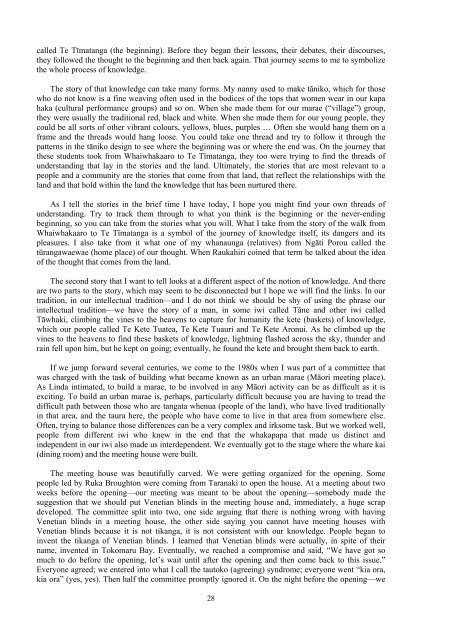traditional knowledge conference 2008 te tatau pounamu
traditional knowledge conference 2008 te tatau pounamu
traditional knowledge conference 2008 te tatau pounamu
Create successful ePaper yourself
Turn your PDF publications into a flip-book with our unique Google optimized e-Paper software.
called Te Tīmatanga (the beginning). Before they began their lessons, their deba<strong>te</strong>s, their discourses,they followed the thought to the beginning and then back again. That journey seems to me to symbolizethe whole process of <strong>knowledge</strong>.The story of that <strong>knowledge</strong> can take many forms. My nanny used to make tāniko, which for thosewho do not know is a fine weaving of<strong>te</strong>n used in the bodices of the tops that women wear in our kapahaka (cultural performance groups) and so on. When she made them for our marae (“village”) group,they were usually the <strong>traditional</strong> red, black and whi<strong>te</strong>. When she made them for our young people, theycould be all sorts of other vibrant colours, yellows, blues, purples … Of<strong>te</strong>n she would hang them on aframe and the threads would hang loose. You could take one thread and try to follow it through thepat<strong>te</strong>rns in the tāniko design to see where the beginning was or where the end was. On the journey thatthese students took from Whaiwhakaaro to Te Tīmatanga, they too were trying to find the threads ofunderstanding that lay in the stories and the land. Ultima<strong>te</strong>ly, the stories that are most relevant to apeople and a community are the stories that come from that land, that reflect the relationships with theland and that hold within the land the <strong>knowledge</strong> that has been nurtured there.As I <strong>te</strong>ll the stories in the brief time I have today, I hope you might find your own threads ofunderstanding. Try to track them through to what you think is the beginning or the never-endingbeginning, so you can take from the stories what you will. What I take from the story of the walk fromWhaiwhakaaro to Te Tīmatanga is a symbol of the journey of <strong>knowledge</strong> itself, its dangers and itspleasures. I also take from it what one of my whanaunga (relatives) from Ngāti Porou called thetūrangawaewae (home place) of our thought. When Raukahiri coined that <strong>te</strong>rm he talked about the ideaof the thought that comes from the land.The second story that I want to <strong>te</strong>ll looks at a different aspect of the notion of <strong>knowledge</strong>. And thereare two parts to the story, which may seem to be disconnec<strong>te</strong>d but I hope we will find the links. In ourtradition, in our in<strong>te</strong>llectual tradition—and I do not think we should be shy of using the phrase ourin<strong>te</strong>llectual tradition—we have the story of a man, in some iwi called Tāne and other iwi calledTāwhaki, climbing the vines to the heavens to capture for humanity the ke<strong>te</strong> (baskets) of <strong>knowledge</strong>,which our people called Te Ke<strong>te</strong> Tua<strong>te</strong>a, Te Ke<strong>te</strong> Tuauri and Te Ke<strong>te</strong> Aronui. As he climbed up thevines to the heavens to find these baskets of <strong>knowledge</strong>, lightning flashed across the sky, thunder andrain fell upon him, but he kept on going; eventually, he found the ke<strong>te</strong> and brought them back to earth.If we jump forward several centuries, we come to the 1980s when I was part of a commit<strong>te</strong>e thatwas charged with the task of building what became known as an urban marae (Māori meeting place).As Linda intima<strong>te</strong>d, to build a marae, to be involved in any Māori activity can be as difficult as it isexciting. To build an urban marae is, perhaps, particularly difficult because you are having to tread thedifficult path between those who are tangata whenua (people of the land), who have lived <strong>traditional</strong>lyin that area, and the taura here, the people who have come to live in that area from somewhere else.Of<strong>te</strong>n, trying to balance those differences can be a very complex and irksome task. But we worked well,people from different iwi who knew in the end that the whakapapa that made us distinct andindependent in our iwi also made us in<strong>te</strong>rdependent. We eventually got to the stage where the whare kai(dining room) and the meeting house were built.The meeting house was beautifully carved. We were getting organized for the opening. Somepeople led by Ruka Broughton were coming from Taranaki to open the house. At a meeting about twoweeks before the opening—our meeting was meant to be about the opening—somebody made thesuggestion that we should put Venetian blinds in the meeting house and, immedia<strong>te</strong>ly, a huge scrapdeveloped. The commit<strong>te</strong>e split into two, one side arguing that there is nothing wrong with havingVenetian blinds in a meeting house, the other side saying you cannot have meeting houses withVenetian blinds because it is not tikanga, it is not consis<strong>te</strong>nt with our <strong>knowledge</strong>. People began toinvent the tikanga of Venetian blinds. I learned that Venetian blinds were actually, in spi<strong>te</strong> of theirname, inven<strong>te</strong>d in Tokomaru Bay. Eventually, we reached a compromise and said, “We have got somuch to do before the opening, let’s wait until af<strong>te</strong>r the opening and then come back to this issue.”Everyone agreed; we en<strong>te</strong>red into what I call the tautoko (agreeing) syndrome; everyone went “kia ora,kia ora” (yes, yes). Then half the commit<strong>te</strong>e promptly ignored it. On the night before the opening—we28
















